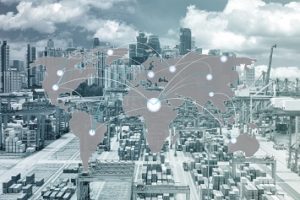As larger companies are realizing the benefits of leaning on their supply chains to be accountable for the environmental and social footprints of components and the products they deliver, supply chain traceability and transparency grow in importance both for regulatory and marketplace reasons. Today we will look at ways you can nudge your supply chain toward lowering their environmental footprint and improving their social standing. Tomorrow we will review some best practices that have worked in companies worldwide to encourage resource efficiency in their supply chains.
According to the Guide to Traceability by the United Nations (U.N.) Global Compact and Business for Social Responsibility (BSR), the desire for traceability began when some European countries wanted to be able to prove the origin of high-quality foods. It has evolved to include the ability to identify and trace the history, distribution, location, and application of products, parts, and materials to ensure the reliability of sustainability claims in the areas of human rights, labor (including health and safety), the environment, and anticorruption.
Show Me
American customers (and many worldwide) are no longer willing to just take your word that you are sourcing products using sustainable and fair labor practices. With the growth of the Internet and data services, many companies are being pressured to develop ways to trace the environmental and social impacts of their supply chain. This may seem easier for larger companies like Target and Nike, but how can medium- and small-sized companies get on the supply chain traceability wagon?
Note: Greenbiz has provided information on supply chain tech companies. While there are others in the field, this a good place to start if you are just beginning your search for supply chain data services.
Five Steps to Implementing Supply Chain Traceability
These suggestions for supply chain traceability at your company are drawn from the U.N./BSR guide and the U.S. Environmental Protection Agency’s (EPA) guidance for engaging suppliers to reduce environmental footprints.
Step 1: Start Small
It is best to engage a small number of key suppliers at first. Identify the commodities that are most important to your business. Focus on your suppliers that comprise 75 percent to 80 percent of your money spent and those who pose the greatest risk to your financial performance or brand reputation if they do not manage their environmental and social footprints. This may include smaller suppliers, those that provide critical components, or those that represent other risk factors, such as energy-intensive operations.
Step 2: Keep It Simple
You should consider using questionnaires and databases to collect information from key suppliers. Keep the information requests simple, and do not ask questions of your suppliers that you would have difficulty answering. Some organizations ask suppliers for quantitative data, while others focus first on qualitative questions as to whether the suppliers are measuring, reporting, and taking steps to reduce environmental and social impacts.
Include clear messages about traceability in your regular exchanges with suppliers.
Step 3: Build Trust by Communication and Collaboration
Think about how you feel when you are asked for information about your facility’s operations. Your suppliers may be sensitive about how their information will be used, some fearing that sharing their data will provide insight into how operations are managed and potentially linked to production costs. Your suppliers may worry that you might use the information to request further cost reductions.
To help build trust, consider first sharing your own success stories about saving money or enhancing competitiveness, lessons learned, tools, and resources with suppliers to demonstrate realized and potential benefits. You can also consider collecting data through third-party programs that protect suppliers’ confidential business information.
Set clear expectations about involvement in the traceability program from the outset, and communicate them regularly through different methods. Traceability programs can be expensive for suppliers, so consider what the expectations are around cost, and provide suggestions for how suppliers can manage costs. Consider your own commitments here; if you are asking suppliers to take on more costs, have a look at your payment terms to ensure they are fair.
Step 4: Provide Training
Suppliers often do not know at first how to measure and report their sustainability efforts and shortcomings. And they fear that doing so will involve extensive resources. Training and capacity building for suppliers are critical components of a customer/supplier relationship built around the goal of managing their environmental and social impacts. Consider having supplier-focused meetings or forums that can be leveraged to include trainings on managing and tracing these impacts. If resources permit, you can also create a standing team to provide technical assistance to suppliers.
Step 5: Stay the Course
Developing and implementing a supply chain traceability program is a long-term commitment. According to the U.N./BSR traceability guide, many of the companies interviewed for the guide revealed that they did have to overcome opposition and, in some cases, demands for a short-term return on investment (ROI). This is a difficult area to calculate financial costs and benefits, and traceability is also a long-term investment in the reputation of the company. It is important to find ways to protect the program from demands for short-term payoffs.
Check tomorrow’s Advisor for some best practices that have worked in companies worldwide to encourage resource efficiency in their supply chains.

